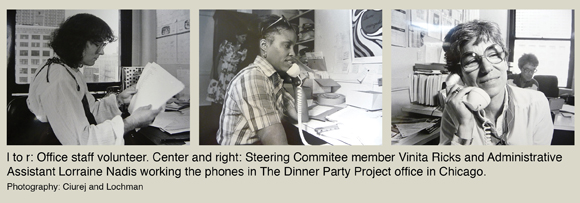
Activists unite to bring The Dinner Party to Chicago click on titles to jump to sections – Coming together/working together – Coming together/working together Meeting every Tuesday from 1979 until the opening in 1981, The Dinner Party Project in Chicago Steering Committee and staff hammered out the details. They reached out to diverse groups to include a network of 1,300 volunteers and supporters who worked to realize the project. It took two years and hundreds of volunteers to accomplish the necessary financial planning, exhibition construction, publicity and cooperation from city, corporate and foundation leaders. – Finding and transforming a space From abandoned factories to warehouses, the group visited over 150 properties, trying to find a suitable site. Space requirements dictated that there be no intervening support structures in a 60’ x 60’ space. Mary Jane Jacobs, curator at the Museum of Contemporary Art suggested the use of the Franklin Building in Printers Row in the South Loop to Bette Cerf Hill, director of the South Loop Planning Board and a Steering Committee member. Printers Row housed the printing and engraving industry in Chicago, but many companies had moved or closed. The area was in transition. With developer Royal Faubian’s generous offer to renovate the first and thirteenth floors including the installation of an elevator, and to provide the space rent free, The Franklin Building at 720 South Dearborn Street was secured to host The Dinner Party exhibition. A fitting inscription over the entrance to the building still reads: “The excellence of every art must consist in complete accomplishment of its purpose.” The enormous task of transforming this raw space into a museum-quality site was in the hands of Pauline Saliga, who moved from her post as curator at the Museum of Contemporary Art to become the Exhibition Coordinator.
Not only did the space need major renovation, but the venue and presentation had to meet the approval of the artist, Judy Chicago, whose standards were high and whose team was uncompromising. Negotiations, construction of the site and the installation of the exhibition were fraught with tensions, setbacks and obstacles; but commitment to the ideals of The Dinner Party exhibition and the willingness of the group to accommodate and preserve the artist’s vision rose above those to realize the project. – Raising funds and generating interest Finding the funds to finance the project in such a short time frame put the staff and committee under tremendous pressure. By the opening, $67,325 in cash had been raised (amounting to $165,511 in 2011 terms) coming from multiple sources. Factoring in in-kind donations, which included hundreds of hours from 1300 volunteers and the build-out costs for the first and thirteenth floors, installation of elevators, and rent and office space for five months, the real costs for the project were closer to $500,000.
Donations Loans Film screenings Special events Press
|



